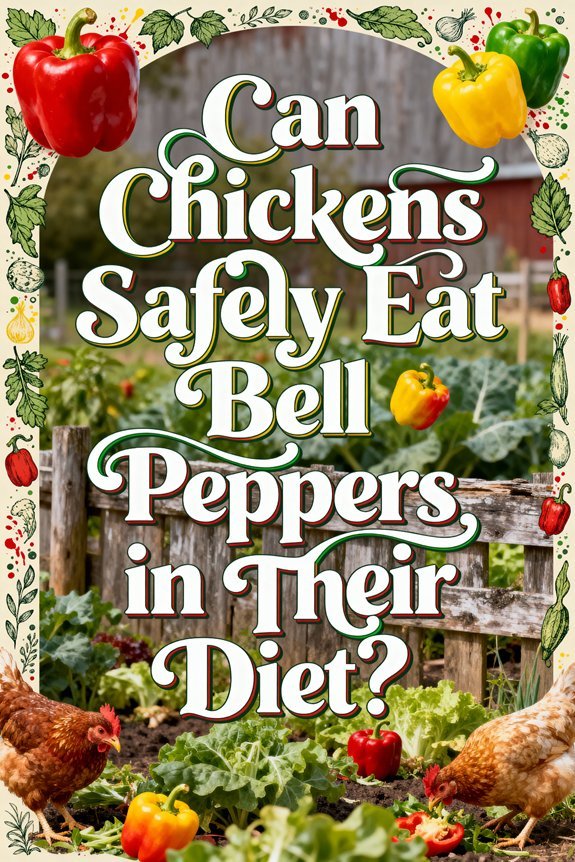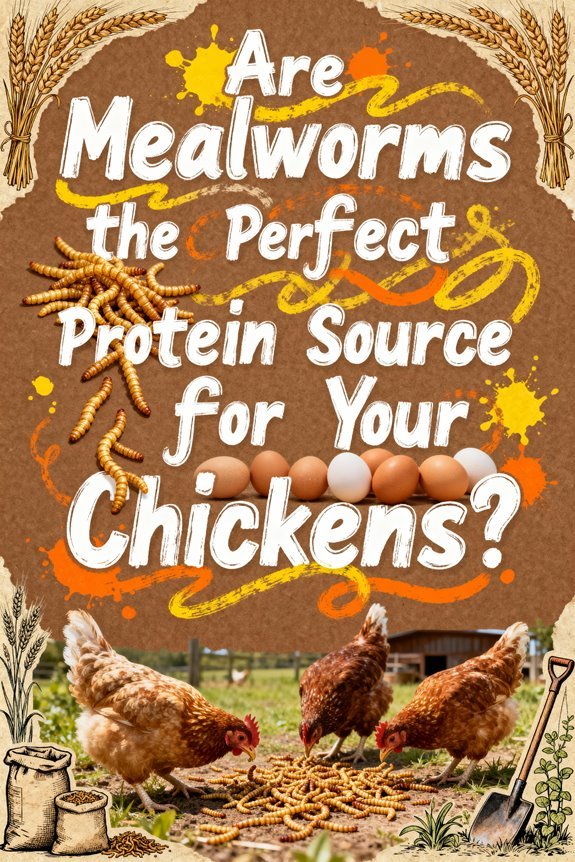Can Chickens Safely Eat Bell Peppers in Their Diet?
Bell peppers are safe and nutritious for your chickens when you feed them the fruit portion only. You’ll need to remove all stems, leaves, and flowers, as these contain toxic solanine. Offer peppers as treats comprising no more than 5% of their total diet, serving them raw or cooked without seasonings 1-2 times weekly. Their vitamin C and antioxidants support immune health and enhance egg yolk color – but that’s just the beginning of their benefits.
Understanding Bell Peppers and Their Safety for Chickens
While bell peppers can provide valuable nutrition for chickens, you’ll need to understand which parts are safe and which are toxic. Bell pepper varieties of all colors – red, yellow, orange, and green – are safe for chickens to consume, but only the fruit portion. The leaves, stems, and flowers contain solanine, a dangerous toxin that can cause severe health issues including paralysis, convulsions, and respiratory problems.
You’ll want to be particularly careful about keeping your chickens away from pepper plant foliage, as even small amounts of solanine can be harmful. While chicken preferences vary, they can safely eat the entire pepper fruit, including seeds. Just remember to avoid feeding them moldy peppers or any parts containing additives like oils, salt, or seasonings that could be harmful to your flock. For optimal health benefits, peppers should be offered as supplemental snacks rather than as a primary food source. These nutritious vegetables provide chickens with essential vitamin A and antioxidants that support their overall health and egg production.
Essential Nutrients Found in Bell Peppers
Bell peppers pack a powerful nutritional punch for your chickens, offering an array of essential vitamins, minerals, and antioxidants. The nutritional profile includes high levels of vitamin C, which supports immune function and helps your flock manage stress. While chickens produce vitamin C naturally, supplemental amounts can boost their health during challenging conditions. A serving of 100 grams contains 31 calories and is mainly water-based.
You’ll find substantial vitamin benefits from the beta-carotene content, particularly in red varieties, which converts to vitamin A and enhances egg yolk color. B vitamins, especially B6 and folate, support metabolism and red blood cell formation. The mineral content includes calcium for strong eggshells, potassium for muscle function, and iron for oxygen transport. Additionally, bell peppers’ antioxidants and phytonutrients help protect your birds from oxidative stress and support their vision health.
The Benefits of Feeding Bell Peppers to Your Flock
When you introduce bell peppers into your chickens’ diet, you’ll provide them with multiple health-promoting benefits that support their overall wellness. The high water content offers significant hydration benefits, especially during hot weather, helping your flock maintain ideal body temperature and reduce heat stress. Remember to remove stems and leaves as these parts contain toxic compounds that can harm your chickens.
Bell peppers deliver a natural energy boost through their carbohydrate content, supporting daily activities and egg-laying functions. They’re rich in vitamins A and C, strengthening your chickens’ immune system and promoting tissue repair. The carotenoids enhance egg yolk color, potentially increasing market appeal.
You’ll also supplement your flock’s mineral intake with essential elements like potassium, calcium, and iron. These minerals support bone development, enzyme function, and metabolic processes, contributing to your chickens’ long-term health and productivity.
Toxic Parts of Bell Pepper Plants to Avoid
Understanding which parts of bell pepper plants pose risks to your chickens is essential for preventing accidental poisoning. You’ll need to keep your flock away from the leaves, stems, and flowers of bell pepper plants, as these toxic parts contain dangerous levels of solanine. This natural alkaloid can cause severe digestive problems, neurological symptoms, and even death in chickens.
Since peppers belong to the nightshade family, proper identification and removal of all toxic plant parts is crucial before feeding. Don’t feed your birds unripe green peppers or any moldy specimens, as these also present solanine risks. Since chickens can’t detect spicy flavors, they won’t naturally avoid these hazardous plant parts. To protect your flock, remove all vegetative material before offering bell peppers, and guarantee your chickens can’t access growing pepper plants. Only feed the ripe fruit portion, carefully trimmed of all stems and leaves.
Best Practices for Serving Bell Peppers to Chickens
To safely incorporate bell peppers into your chickens’ diet, proper serving practices must be followed. Begin by thoroughly washing the peppers to remove pesticides and contaminants. Remove stems and seeds, then chop into small, manageable pieces that your birds can easily consume. Try hanging peppers or using a feeding cage setup to provide entertainment and enrichment for your flock.
When considering serving sizes, limit bell peppers to 5% of your chickens’ total diet, offering them once or twice weekly. You’ll want to introduce these treats gradually while monitoring for any adverse reactions. Your preparation methods should focus on serving peppers either raw or cooked, without added seasonings or oils. Don’t replace their regular feed – instead, offer peppers alongside it. This approach guarantees your flock receives the nutritional benefits of bell peppers while maintaining a properly balanced diet.
How Bell Peppers Impact Egg Production
Bell peppers greatly influence egg production by enhancing yolk coloration, shell strength, and overall egg quality. When you add hot red pepper powder to your chickens’ feed, you’ll notice increased egg yolk pigmentation due to natural carotenoids, resulting in more vibrant yolks that appeal to consumers. You’ll also see improvements in shell thickness and internal density.
Adding pepper supplements at appropriate levels can lead to egg weight increase and higher total production. The bioactive compounds in peppers, including capsaicin and carotenoids, support hen health through antioxidant effects and improved blood circulation to reproductive organs. These benefits translate to better egg shape, reduced breakage rates, and extended freshness during storage. During prolonged storage, eggs experience rupture of vitelline membranes and other quality changes, making preservation techniques crucial. For ideal results, incorporate approximately 0.5% hot red pepper powder into your chickens’ diet.
Recommended Quantities and Feeding Schedule
While maximizing egg production through pepper supplementation is valuable, proper portioning and timing of bell peppers in your chickens’ diet will determine their effectiveness as a treat. You’ll want to limit bell peppers to 2-3 times per week, serving them in the morning as small portions that comprise less than 10% of their total diet balance. While bell peppers are excellent for chickens, ensure you remove stems and flowers as these parts contain toxins that could harm your flock.
To maintain treat variety, rotate bell peppers with other vegetables and fruits. Offer just a few pieces per chicken daily, either raw or lightly cooked, after removing stems and leaves. You’ll need to introduce them gradually and monitor your flock’s response. If you notice any digestive issues, reduce the quantity immediately. Remember to track all treats given to guarantee you’re staying within the recommended 5-10% treat-to-feed ratio.
Signs of Bell Pepper Intolerance in Chickens
Monitoring your chickens for signs of bell pepper intolerance is essential for their health and wellbeing. Watch for digestive disturbances like bloating, diarrhea, or soft stools, as these are primary indicators of intolerance. You’ll notice affected birds showing increased restlessness or pecking at their belly area, suggesting abdominal discomfort.
Proper symptom identification includes observing behavioral changes such as irritability or reduced activity levels. Your chickens might display respiratory issues like wheezing or coughing, along with nasal discharge. Just as in humans, chickens may experience swelling of face after consuming bell peppers. If you suspect intolerance, implement immediate dietary adjustments by removing bell peppers from their feed. Document when symptoms occur and whether they improve after elimination. Pay special attention to recurring symptoms that emerge after bell pepper consumption, as this pattern confirms intolerance rather than coincidental illness.
Combining Bell Peppers With Other Chicken Treats
Combining bell peppers strategically with other chicken treats maximizes nutritional benefits and promotes ideal health outcomes. The nutrient synergy between bell peppers and protein-rich treats like mealworms enhances amino acid absorption, while pairing them with leafy greens amplifies antioxidant intake. You’ll find that treat combinations featuring bell peppers alongside carrots or marigold petals intensify egg yolk color and boost overall nutritional value. Red bell peppers provide the highest antioxidant levels compared to other varieties, making them an ideal choice for treat combinations. Offering stone fruits safely requires complete removal of pits before combining with bell peppers. Fresh wild blackberries can be mixed with bell peppers for an antioxidant-rich treat that chickens enjoy.
When creating treat mixes, maintain a 5% limit of bell peppers in the total diet, and rotate combinations weekly. Cut peppers into small pieces, removing seeds and stems, then combine with other fresh vegetables. Both sweet and hot peppers can be safely included together, as chickens don’t react to capsaicin, providing additional immune support and natural parasite control.


